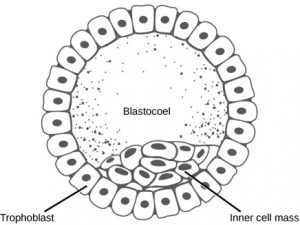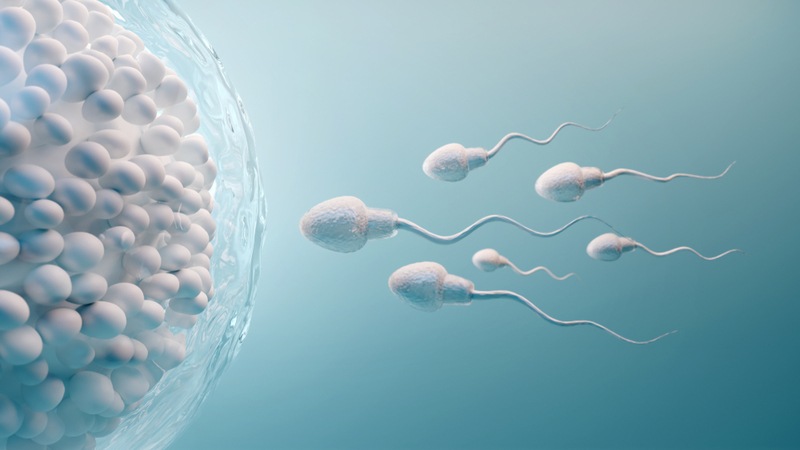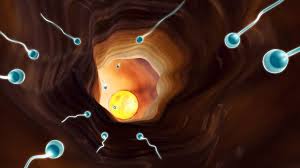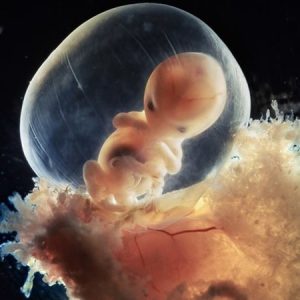Why so many sperms?
If it only needs one sperm and one ovum to fuse and create a baby, then why do men produce such a large number of sperms?
Just after the ejaculation, the sperms get exposed to acidic vaginal fluid (pH about 5). This will kill some sperms even though the more basic pH of the semen (about 7.4) tries to neutralize the acidity. Many sperms will quickly leave the vagina within minutes, entering the cervix.
In the cervix, sperms have to face another challenge. The cervical mucus, particularly at the borders, is compact with a micro-architecture that is hard to penetrate for sperms with abnormalities. This also acts as a selection mechanism, preventing the fusion of the egg cell with abnormal or unhealthy sperm. Another challenge in the cervix is the female’s immune response against sperms. White blood cells approach the cervix to attack foreign cells.
Usually, these WBCs attack bacteria entering the female reproductive system through the vagina. But sometimes they may attack the sperm cells. The sperm that gets through the cervix and avoids attack by WBCs then needs to find the proper path into the uterus. This journey is difficult as they need to travel through the grooves of the cervix. So the sperms have to face many challenges to go through the cervix.
Only those sperms that make it through the cervix enter the uterus. In the uterus, sperms have to face some challenging situations. Again WBCs migrate to the uterus to attack them. The uterus also needs to have proper muscle contractions to promote sperms travel through the uterus and reach the fallopian tubes. Abnormalities in the uterine wall can cause defective contraction patterns, which may cause infertility.
The fallopian tubes provide much more favorable conditions for the sperms, and the sperms can be stored temporarily within the crypts on their walls. Once the sperms get close to the egg, they undergo several complex steps to get ready for fertilization. Only the best sperms can do these preparatory steps and have to be chromosomally normal (many are not). The sperms then need to go through capacitation (changing the sperm’s surface) and hyperactivation (changing the sperm’s tail motion). One lucky sperm among these cells will grab the chance to fertilize with the egg.
So the answer to the question “Why men have to produce so many sperms?” is pretty simple. The more sperms you produce means the higher probability of fertilization. This is a key factor that determines the fitness of the male. Hence it has played an important role in the evolution of man through natural selection.
When the sperm meets the ovum
When the sperm comes in contact with the ovum, the Acrosome reaction occurs. It is a calcium-dependent reaction that results in the exocytosis of the outer acrosome membrane, allowing acrosome enzymes to be released. Some of these enzymes are stored in their inactive forms. Once they come into contact with certain molecules in the zona pellucida, they are converted into active forms that are capable of acting on the membrane. These enzymes assist the sperm cell to penetrate the egg envelopes and enter the egg for fertilization to take place.
Once the sperm cell enters the egg, the egg cell completes meiosis. Nuclear fusion occurs and makes up 46 diploid chromosomes, which determines the characteristics of the new organism. Fertilization induces changes in the egg membranes, reducing the ability of another sperm to fuse with the egg in a mechanism known as the polyspermy block. If not multiple sperms can fuse with the egg and the resulting embryo will not be genetically viable, therefore die within few days. The newly formed diploid single cell is called the zygote.
From a single cell to a baby!
The zygote undergoes rapid mitotic cell division, termed cleavage. Each division takes about 24 hours. At the 32-cell stage, the zygote is known as a morula. Once the cleavage has produced over 100 cells, the zygote is now called a blastula. It is spherical and made of a single layer of cells (blastoderm) surrounding a fluid-filled cavity (blastocoel).
The blastula develops further to become the blastocyst. Here, the cells in the blastula arrange in two layers as the inner cell mass, and an outer layer called the trophoblast. The inner cell mass, also known as the embryoblast will form the embryo and the trophoblast will form the placenta and nourish the embryo. The inner cell mass consists of embryonic stem cells that will differentiate into different cell types in the body.

The blastula then undergoes a process called gastrulation. During gastrulation, the blastula folds upon itself and its cells rearrange to form three layers of cells; endoderm, mesoderm, and ectoderm. These three layers are called germ layers. Each germ layer differentiates and builds up different organ systems. The ectoderm gives rise to the nervous system and the epidermis. The mesoderm gives rise to the muscle cells and connective tissues. The endoderm gives rise to columnar cells found in the digestive system and many internal organs.

The blastocyst enters the mother’s uterus and attaches to the endometrium, which is known as implantation. After 2 weeks from fertilization, the baby is now called the embryo. The placenta and the body organs of the baby start to develop. The placenta transfers nutrients and oxygen needed for the baby from the mother and removes excretory products and carbon dioxide from the baby.
Within 1 month from fertilization, the face begins to take its shape, with two dark spots for the eyes, mouth, and throat develops. Blood circulation will begin even the heart has not completely developed. After the 8th week, the embryo is called a fetus. At the end of the first trimester, the fetus is about 4 inches long and weighs about 1 ounce. The arms, fingers, legs, and toes are fully formed. The reproductive organs start to form and the circulatory and excretory systems are functioning.
During the second trimester, eyelids, eyebrows, nails, and hair are formed. Teeth and bones start becoming denser. The nervous system starts to function. The reproductive organs are fully developed. Hair begins to grow on the baby’s head, and the body is mostly covered by a soft hair called lanugo. The eyelids begin to part and the eyes open. By the end of the sixth month, the baby responds to sounds.
In the final trimester, the baby will continue to grow and mature. Subcutaneous fat begins to deposit. The baby’s brain is developing rapidly. Lungs complete development. At the end of this period, the baby is about 18 to 20 inches long and weighs about 3 kilograms. The baby’s position changes to prepare for birth, the head of the fetus in the uterus, turns towards the vagina. Now the baby is ready to see the world!
Written by: Dhanuka Dilshan
References:
https://www.tandfonline.com/doi/full/10.1080/19420889.2015.1017156
https://journals.plos.org/plosbiology/article?id=10.1371/journal.pbio.3000953
https://opentextbc.ca/biology/part/chapter-24-animal-reproduction-and-development/
Image courtesies:
- Title image: https://bit.ly/3xxPlS4
- Image 01: https://bit.ly/3eE2qAB
- Image 02: https://bit.ly/3eAz860
- Image 03: https://bit.ly/3t16QH3
- Image 04: https://bit.ly/32YR0C0
- Image 05: https://bit.ly/3nrPtxX




